Showing Spotlights 1497 - 1504 of 2798 in category All (newest first):
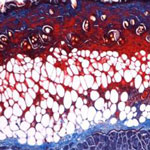 Candida albicans is a leading fungal cause of burn infections in hospital settings. The prevalence of invasive candidiasis in burn cases varies widely, but it accounts as high as 23% of severe infection with a mortality rate ranging from anywhere to 14% to 70%. In a recent pre-clinical study, a nitric oxide releasing nanoparticle platform, which has previously been shown to be antibacterial to both gram positive and negative bacteria, as well as an accelerator of wound healing in excisional animal models, was found to be efficacious in clearing candidal burn infections in mice. This study represents one of many pre-clinical investigations demonstrating the efficacy of the NO nanoparticles as a broad spectrum antimicrobial agent as well as wound healing accelerant.
Candida albicans is a leading fungal cause of burn infections in hospital settings. The prevalence of invasive candidiasis in burn cases varies widely, but it accounts as high as 23% of severe infection with a mortality rate ranging from anywhere to 14% to 70%. In a recent pre-clinical study, a nitric oxide releasing nanoparticle platform, which has previously been shown to be antibacterial to both gram positive and negative bacteria, as well as an accelerator of wound healing in excisional animal models, was found to be efficacious in clearing candidal burn infections in mice. This study represents one of many pre-clinical investigations demonstrating the efficacy of the NO nanoparticles as a broad spectrum antimicrobial agent as well as wound healing accelerant.
May 21st, 2012
 Nanotechnology-based food and health products and food packaging materials are available to consumers in some countries already, and additional products and applications are currently in the research and development stage, and some may reach the market soon. In view of such progress, it is expected that nanotechnology-derived food products will be increasingly available to consumers worldwide in the coming years. Some of these products appear to already be in commercial use in other countries, raising the likelihood that they could become a part of our food supply in the near future, if they are not already. This article looks at how regulators are dealing with the pressures to commercialize nanotech foods and food packaging.
Nanotechnology-based food and health products and food packaging materials are available to consumers in some countries already, and additional products and applications are currently in the research and development stage, and some may reach the market soon. In view of such progress, it is expected that nanotechnology-derived food products will be increasingly available to consumers worldwide in the coming years. Some of these products appear to already be in commercial use in other countries, raising the likelihood that they could become a part of our food supply in the near future, if they are not already. This article looks at how regulators are dealing with the pressures to commercialize nanotech foods and food packaging.
May 16th, 2012
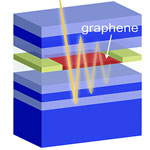 There is currently a very strong interest in using graphene for applications in optoelectronics. Graphene-based photodetectors have been realized before. By using graphene, researchers make use of the internal electric field that exists at the interface of graphene and metal. However, the low optical absorption of graphene - only 2.3 % due to its monoatomic thickness - leads to a low responsivity of these devices. Several groups worldwide are therefore currently pursuing different approaches to increase the interaction length of light with graphene and enhance the optical absorption. One novel approach is based on the integration of graphene into an optical microcavity. The increased electric field amplitude inside the cavity causes more energy to be absorbed, leading to a significant increase of the photoresponse.
There is currently a very strong interest in using graphene for applications in optoelectronics. Graphene-based photodetectors have been realized before. By using graphene, researchers make use of the internal electric field that exists at the interface of graphene and metal. However, the low optical absorption of graphene - only 2.3 % due to its monoatomic thickness - leads to a low responsivity of these devices. Several groups worldwide are therefore currently pursuing different approaches to increase the interaction length of light with graphene and enhance the optical absorption. One novel approach is based on the integration of graphene into an optical microcavity. The increased electric field amplitude inside the cavity causes more energy to be absorbed, leading to a significant increase of the photoresponse.
May 14th, 2012
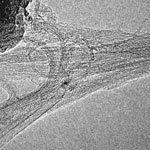 Nanofluids - engineered colloidal suspensions of nanoparticles in a base fluid - are attracting a great deal of interest with their enormous potential to provide enhanced performance properties. Particularly with respect to heat transfer, and compared with more conventional heat transfer fluids (i.e. coolants) currently available, nanofluidic coolants exhibit enhanced thermal conductivity. Attempts to increase the thermal conductivity of heat transfer fluids using nanoparticles has been an active research area over the past decade. However, these attempts have not resulted in a significant improvement in conductivity due to the low thermal conductivity of nanoparticles and high thermal boundary resistance around the 0-dimensional nanoparticles. Researchers have therefore decided to produce a nanofluid using single-walled carbon nanotubes because of their much higher thermal conductivity and their ability to form connected networks with the neighboring carbon nanotubes, thereby increasing the heat transfer path.
Nanofluids - engineered colloidal suspensions of nanoparticles in a base fluid - are attracting a great deal of interest with their enormous potential to provide enhanced performance properties. Particularly with respect to heat transfer, and compared with more conventional heat transfer fluids (i.e. coolants) currently available, nanofluidic coolants exhibit enhanced thermal conductivity. Attempts to increase the thermal conductivity of heat transfer fluids using nanoparticles has been an active research area over the past decade. However, these attempts have not resulted in a significant improvement in conductivity due to the low thermal conductivity of nanoparticles and high thermal boundary resistance around the 0-dimensional nanoparticles. Researchers have therefore decided to produce a nanofluid using single-walled carbon nanotubes because of their much higher thermal conductivity and their ability to form connected networks with the neighboring carbon nanotubes, thereby increasing the heat transfer path.
May 11th, 2012
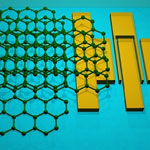 Gallium Nitride (GaN) is a semiconductor material commonly used in bright light-emitting diodes since the 1990s, which are now found in traffic lights and solid-state lighting. Thanks to its wide band gap, this very hard semiconductor material also finds applications in optoelectronic, high-power and high-frequency devices. However, a severe problem that afflicts high-power GaN electronic and optoelectronic devices is self-heating and the difficulties of heat removal. Researchers have now found an unusual solution for the thermal management problem of gallium-nitride technology: They demonstrated that thermal management of GaN transistors can be substantially improved via introduction of alternative heat-escaping channels implemented with graphene multilayers.
Gallium Nitride (GaN) is a semiconductor material commonly used in bright light-emitting diodes since the 1990s, which are now found in traffic lights and solid-state lighting. Thanks to its wide band gap, this very hard semiconductor material also finds applications in optoelectronic, high-power and high-frequency devices. However, a severe problem that afflicts high-power GaN electronic and optoelectronic devices is self-heating and the difficulties of heat removal. Researchers have now found an unusual solution for the thermal management problem of gallium-nitride technology: They demonstrated that thermal management of GaN transistors can be substantially improved via introduction of alternative heat-escaping channels implemented with graphene multilayers.
May 10th, 2012
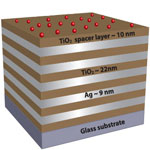 Physicists have uncovered a new method to manipulate light by borrowing an idea from the field of mathematical topology - topology is the mathematical field dealing with the properties of objects undergoing deformations, such as stretching and twisting. They created an artificial material, a "metamaterial", that can transform from regular dielectric - a substance like glass or plastic, which does not conduct electricity - to a medium that behaves like metal (reflects) in one direction and like dielectric (transmits) in the other. The research team expects optical topological transition to be the basis for a number of applications of both fundamental and technological importance through use of metamaterial-based control of light-matter interaction.
Physicists have uncovered a new method to manipulate light by borrowing an idea from the field of mathematical topology - topology is the mathematical field dealing with the properties of objects undergoing deformations, such as stretching and twisting. They created an artificial material, a "metamaterial", that can transform from regular dielectric - a substance like glass or plastic, which does not conduct electricity - to a medium that behaves like metal (reflects) in one direction and like dielectric (transmits) in the other. The research team expects optical topological transition to be the basis for a number of applications of both fundamental and technological importance through use of metamaterial-based control of light-matter interaction.
May 9th, 2012
 Thin films comprising carbon-based molecules and polymers have promising technological applications, such as biosensors, solar cells, electrically-active and light-emitting layers for displays, etc. Oftentimes, properties, such as luminescence and conductivity, depend on the orientation of crystals within the film. In organic thin films deposited on substrates, crystallization most often occurs isotropically in the plane of the film. Much research has thus focused on controlling the orientation of crystals in the plane of organic thin films. The use of temperature gradients and gravitational flow have been successfully employed to orient crystals unidirectionally. Two-dimensional control of the orientation of crystals spatially within organic thin films, however, remains exceedingly difficult to achieve. In new work, researchers have now demonstrated a method to guide crystallization along arbitrary patterns in the plane of organic thin films, using an organic semiconductor.
Thin films comprising carbon-based molecules and polymers have promising technological applications, such as biosensors, solar cells, electrically-active and light-emitting layers for displays, etc. Oftentimes, properties, such as luminescence and conductivity, depend on the orientation of crystals within the film. In organic thin films deposited on substrates, crystallization most often occurs isotropically in the plane of the film. Much research has thus focused on controlling the orientation of crystals in the plane of organic thin films. The use of temperature gradients and gravitational flow have been successfully employed to orient crystals unidirectionally. Two-dimensional control of the orientation of crystals spatially within organic thin films, however, remains exceedingly difficult to achieve. In new work, researchers have now demonstrated a method to guide crystallization along arbitrary patterns in the plane of organic thin films, using an organic semiconductor.
May 8th, 2012
 The study focused on the following questions: What do consumers know about nanotechnologies? How do they rate nanotechnologies? How do they obtain information? How would they like to be informed in the future? The results show that the "Nano-Hype" appears to be fading. Surprisingly, regarding the quality of the consumers' statements, e.g. how detailed their descriptions of the individual examples are, it can be said that their knowledge about all fields of application has decreased. Even though the knowledge about all fields of application has decreased, particularly striking is the decline in the fields of surface coatings, construction materials and environmental engineering. In sum, it can be hypothesised that consumer communication on the part of product manufacturers has decreased considerably, or that the information does not reach the target group to the same extent. The public knowledge on nanotechnologies has become more abstract.
The study focused on the following questions: What do consumers know about nanotechnologies? How do they rate nanotechnologies? How do they obtain information? How would they like to be informed in the future? The results show that the "Nano-Hype" appears to be fading. Surprisingly, regarding the quality of the consumers' statements, e.g. how detailed their descriptions of the individual examples are, it can be said that their knowledge about all fields of application has decreased. Even though the knowledge about all fields of application has decreased, particularly striking is the decline in the fields of surface coatings, construction materials and environmental engineering. In sum, it can be hypothesised that consumer communication on the part of product manufacturers has decreased considerably, or that the information does not reach the target group to the same extent. The public knowledge on nanotechnologies has become more abstract.
May 2nd, 2012
 Candida albicans is a leading fungal cause of burn infections in hospital settings. The prevalence of invasive candidiasis in burn cases varies widely, but it accounts as high as 23% of severe infection with a mortality rate ranging from anywhere to 14% to 70%. In a recent pre-clinical study, a nitric oxide releasing nanoparticle platform, which has previously been shown to be antibacterial to both gram positive and negative bacteria, as well as an accelerator of wound healing in excisional animal models, was found to be efficacious in clearing candidal burn infections in mice. This study represents one of many pre-clinical investigations demonstrating the efficacy of the NO nanoparticles as a broad spectrum antimicrobial agent as well as wound healing accelerant.
Candida albicans is a leading fungal cause of burn infections in hospital settings. The prevalence of invasive candidiasis in burn cases varies widely, but it accounts as high as 23% of severe infection with a mortality rate ranging from anywhere to 14% to 70%. In a recent pre-clinical study, a nitric oxide releasing nanoparticle platform, which has previously been shown to be antibacterial to both gram positive and negative bacteria, as well as an accelerator of wound healing in excisional animal models, was found to be efficacious in clearing candidal burn infections in mice. This study represents one of many pre-clinical investigations demonstrating the efficacy of the NO nanoparticles as a broad spectrum antimicrobial agent as well as wound healing accelerant.
 Subscribe to our Nanotechnology Spotlight feed
Subscribe to our Nanotechnology Spotlight feed





